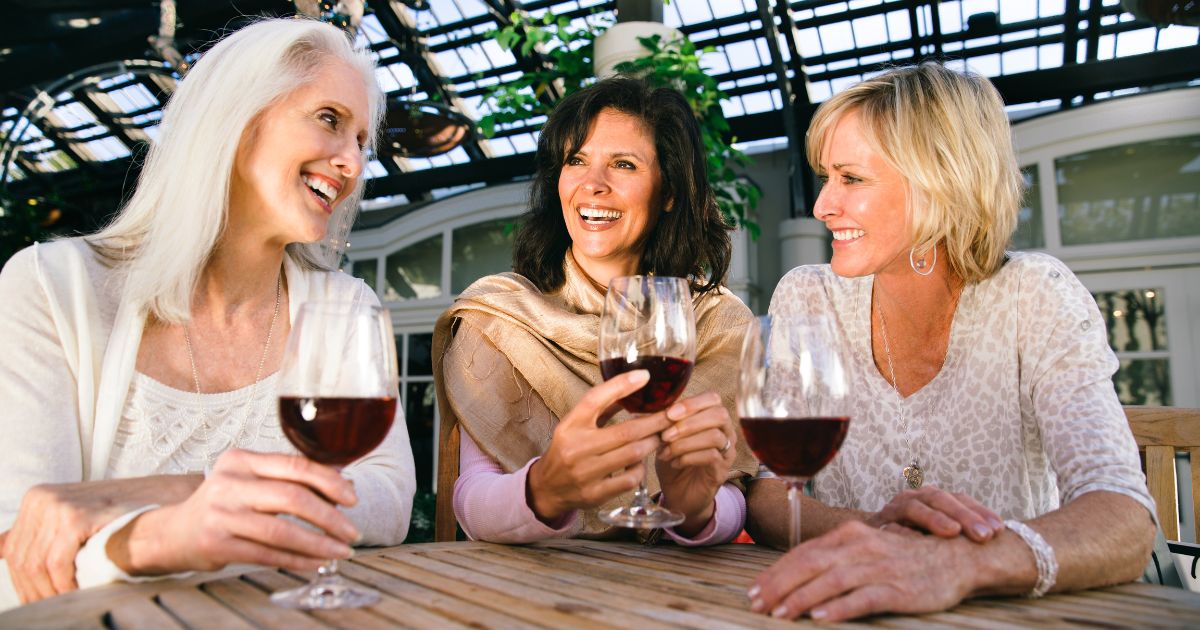
And Just Like That…A True Portrayal Of Life In Your 50’s?
The return of And Just Like That… has drawn millions of viewers, especially women over 45 who grew up with Sex and the City and now want to see their own lives reflected on screen. The show gives us familiar faces navigating new seasons: grief, menopause, adult kids, and second acts in love. It’s glossy, funny, and sometimes raw. But how true to life are the relationships we see? This post looks at what rings true, what feels like TV magic, and what you can take from the characters’ stories to use in your own dating, love, sex, and relationship life in your 50s, 60s, and 70s.
We’ll look at three storylines: Carrie dating again after loss, Charlotte keeping a long marriage alive, and Miranda starting over as a newly out lesbian. Along the way, you’ll get practical tips you can use right now—whether you’re swiping, married, or redefining what love looks like.
Why And Just Like That… Keeps So Many Women Watching
The show taps into a powerful mix: nostalgia, fashion, and the real questions many of us face later in life. Women over 50 are an active TV audience with spending power and strong opinions about representation. Seeing characters talk about widowing, hormone therapy, long-term marriage, and queer identity after midlife is rare. That alone pulls people in. But TV also compresses time and wraps hard moments in perfect lighting. It helps to watch with both enjoyment and a critical eye.
Many viewers say they watch to feel less alone. The series gives language to shifts they’re living through: dating after decades off the market, renegotiating sex after menopause, parenting adult kids, and finding community when friends’ lives diverge. Even when the storylines stretch credulity, the emotions underneath often feel accurate.
Carrie: Dating Again After Loss
Carrie’s journey from widowhood to dating again resonates for anyone who has lost a spouse or long-term partner. The show portrays grief as non-linear: one day she’s hopeful, the next she’s overwhelmed by memories. That unpredictability is honest. Where the show leans into fantasy is the ease with which eligible, charming suitors appear and how quickly new apartments and opportunities materialize. For most people, the path back to dating is slower and messier.
If you’re re-entering the dating world after loss, it’s normal to feel guilty about moving on, to compare every date to your late partner, or to feel waves of sadness even as you enjoy someone new. You can honor your past and still build a future. The key is pacing yourself and being upfront with potential partners. You don’t need a dramatic storyline; you need safe, steady steps.
Practical steps for dating after bereavement
- Start with social reconnection. Join one or two recurring activities (book clubs, walking groups, classes). Practice small talk and rebuild social confidence without the pressure of romance.
- Name your stage of grief in your dating profile or early chats, if you feel comfortable: “Widowed in 2022; taking things slow.” It sets expectations and filters in empathetic matches.
- Set a pace rule. For example: two dates per month for the first three months. Slow pacing helps you notice your feelings instead of getting swept up.
- Create a memory ritual. Before a date, take five minutes to honor your late partner—a photo, a short note, or gratitude. This reduces guilt spikes and grounds you.
- Build a support trio. Ask two friends and one counselor or coach to be your sounding board. Share the ups and downs so you don’t carry them alone.
- Use “yellow light” language when you’re unsure: “I’m enjoying getting to know you, and I’m moving at a gentle pace.” Clear beats perfect.
Charlotte: Keeping a Long Marriage Alive
Charlotte represents the partner who chose family stability and now faces midlife’s quiet tests: changing bodies, shifting desires, kids growing up, and new career stirrings. Her marriage looks polished, but the show hints at the work beneath the surface—negotiating sex frequency, managing invisible labor, and redefining identity beyond “mom.” That strain is real for many long-term couples. Where the series glosses is how quickly conflicts resolve and how often resources (nannies, money, time) smooth rough edges.
Long marriages thrive not because nothing changes, but because both people keep adapting. Desire ebbs and flows. Roles need updating. Resentments build when unspoken. Charlotte’s attempts to reclaim personal time and renegotiate duties point to a broader truth: the best midlife marriages are honest about needs and flexible about solutions.
Actions for rekindling connection in long-term relationships
- Run a “relationship retro.” Each quarter, ask three questions: What worked well? What felt heavy? What do we want more of? Keep it to 30 minutes and one small change each.
- Audit the invisible labor. List household and emotional tasks. Rebalance or rotate two tasks for the next month and revisit.
- Create a micro-intimacy habit. Daily 6-second kiss, 20-second hug, or a 10-minute device-free talk in the evening. Small rituals rebuild warmth.
- Reset your sex script. Try scheduling intimacy windows (not just sex) twice a week where anything from massage to cuddling counts. Pressure down, connection up.
- Share personal goals. Each partner states one non-family goal for the next 90 days. Support each other’s time to pursue it.
- Align on money and caregiving. Midlife often brings aging-parent needs and financial shifts. Calendar a yearly check-in to reduce friction and surprises.
Miranda: Coming Out and Dating as a Lesbian Later in Life
Miranda’s storyline surfaced a topic many didn’t see coming: realizing you’re queer in your 50s or 60s and starting over. The show captures the exhilaration of new identity and the upheaval it causes in family, friendships, and self-image. It also shows impulsive choices and messiness, which, while dramatic, can feel destabilizing for viewers living through similar changes. In real life, you can move toward authenticity without burning your whole life down overnight.
Late-in-life coming out often arrives in layers—curiosity, exploration, disclosure, and integration. There’s no single right timeline. What helps is building community, learning the culture, and dating with care while you figure out what feels right. Courage and tenderness both matter.
Tips for exploring sexuality and queer dating after 50
- Start with identity literacy. Read memoirs, listen to podcasts, and attend local LGBTQ+ center events. Learn language and history; it builds confidence.
- Seek supportive spaces. Try meetups for women-loving-women 40+, queer book clubs, or arts groups. Friendship first makes dating safer and richer.
- Design your disclosure. Decide who you tell first, what you’ll say, and how to handle questions. A script reduces stress.
- Try low-stakes dates. Coffee or daytime walks over high-pressure dinners. Keep first dates to 60–90 minutes to protect your energy.
- Expect mixed reactions. Some friends cheer; others need time. Share your needs clearly and lean on allies who show up.
- Protect your legal and financial interests. If your relationship status changes, update wills, beneficiaries, and shared assets with a professional.
And Just Like That: What’s Realistic—and What’s Not
The series gets several things right: grief is jagged, long marriages require renegotiation, and identity can shift even after decades. It also compresses reality. Dating pools aren’t always sparkling, apartments don’t appear on cue, and conflicts rarely resolve in a neat montage. The fashion is fantasy, but the feelings can be true.
If you use the show as a mirror, you might see parts of yourself in each friend: Carrie’s tenderness for the past, Charlotte’s devotion to family, Miranda’s push for authenticity. Let that be permission to honor your needs and to take one next step. You don’t need a TV-level plot twist. You need the right conversations, habits, and communities.
How to make the most of dating and relationships later in life
- Clarify your season. Are you healing, exploring, or ready to commit? Your season guides your pace and your boundaries.
- Update your profile and photos. Keep copy short, warm, and specific. Use recent, natural-light photos that look like you today.
- Choose two apps or communities, not six. Depth beats breadth. Check in twice a day, 10 minutes each, and log off.
- Set three non-negotiables and three nice-to-haves. Share them with a friend to stay accountable.
- Practice gentle no’s. “I enjoyed our chat. I don’t feel a match. Wishing you well.” Clear, kind, done.
- Keep your health in the loop. Menopause, medications, and mobility affect energy and libido. Talk with your clinician and your partner.
- Diversify intimacy. Touch, laughter, shared projects, and quiet companionship count as connection. Define intimacy broadly.

Friendship as the fourth love story
One lesson the show never lets go of is the power of enduring friendship. In later life, friends can be your emergency contact, your comic relief, and your truth-tellers. If you’re single, friendship is the scaffolding that makes dating safer. If you’re partnered, friendship keeps you from loading every need onto one person. Invest in this love story with intention: schedule standing dates, celebrate small wins, and allow friends to change over time without losing the thread.
Handling rejection, regret, and the awkward middle
The elegant way characters bounce back after heartbreak can feel out of reach. Off-screen, the middle is awkward. Messages go unanswered, first dates fizzle, old patterns show up. That doesn’t mean you’re doing it wrong. It means you’re human. Measure progress by reps, not outcomes: conversations started, boundaries kept, evenings spent with good people. Master the art of short recoveries. When something stings, give yourself 24 hours of care—walk, journal, call a friend—then take the smallest next step.
Midlife Truths
“And Just Like That” is a stylish lens on familiar midlife truths. It exaggerates many details, but it doesn’t invent the core challenges: rebuilding after loss, keeping love alive when life gets busy, and owning new parts of yourself. Let the show entertain you. Then translate what moves you into one concrete action.
That’s where stories become change.











